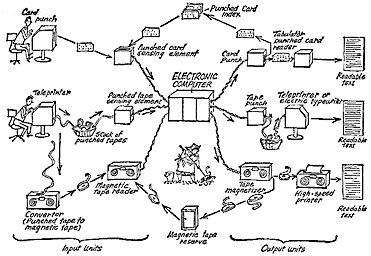Output Units
So far, we have been talking about how information is fed into electronic computers. The apparatus necded for this purpose is called an "input unit". Consequently, the machine by which the computer can most effectively express its opinions is called an "output unit".
One output unit, for example, is the tape punch. Its perforating pins are actuated by the electrical pulses of the computer, and they punch 50 characters or even more per second in an output paper tape. There are output card punches, too. To reconvert every character into a legible letter or number, the tapes must be deciphered by a teleprinter, and the punched cards by a "tabulator". You may not want immediately to read the results accomplished by the machine; for that matter, you may have no wish to read the results at all. They may simply be intermediate results which will be processed by the computer later on. They may be statements of accounts you do not need to have in black and white at your fingertips every day; they will serve their purpose if they are retained and presented at the end of the month. In such cases, you keep the pulses issued by the computer in reserve on long magnetic tapes, from which the machine can pick them up again at a later date.
But if you want to know what is on the magnetic tapes, you spool them through a complicated electronic device which leads the magnetized impulses to a "high speed printer". This is a very much speeded-up typewriter which can tap out ten lines, each containing between 100 and 200 characters, in a single second: 2.000 characters per second - nearly as many as on one page of a book. A rapid typist can tap only five keys a second.
The high speed printer is 400 times faster.
Naturally, the high speed printer is capable of playing such tricks that no typist is a match for it. Each of the 100 or 200 characters in a line has its own set of type, attached to a drum which in its turn is controlled by the pulses of the magnetic tape. In this way the apparatus always types a whole line at once.
Common politeness demands that we introduce - even if only briefly - quite a few other helpful appliances; in a way, they might be called the duplicating equipment of the electronics industry. They transfer - without changing the code - information from punched tapes to punched cards, from magnetic tapes to punched tapes, from punched cards to magnetic tapes. These machines - "converters" - are capable semi-mechanical and semi-electronic devices with nothing extraordinary about them. They do not work at remarkably high speeds, and their work is as unpretentious and modest as that of the cleaners in the factory. For instance, if the shipping manager of a large company goes to the electronic computer with a thousand punched cards in his arms to have something worked out, it may happen that the operator will relieve him of the whole pile and first of all make one of the auxiliary machines copy, on magnetic tape, everything the cards have to say. That may take half an hour. Then the shipping manager gets his punched cards back. The operator now has everything he needs to make his calculations - on about ten yards of tape. It is easier to deal with this than with a thousand cards. Moreover, the tape can whiz through the electronic reader, when the calculation is to be made, in ten seconds; feeding it direct from the punched cards would take about four minutes. Four minutes may not seem very long for us, but for an electronic computer, which measures time in millionths of seconds, it is half an eternity.
We have spoken once more of the terrific speed of electronic computers, and probably you still don't know quite what to make of it. Just how does the apparatus count so fast?
Patience! We shall be starting to tell you all about that in the next chapter.

Multiplication is Vexation >>>>
©
by PhiloPhax & Lauftext
& Redaktion Lohberg
Kybernetik
- Was ist das?
First printed in Germany: 1963